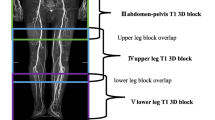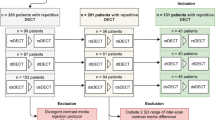Abstract
Total-body contrast-enhanced MRA (CE-MRA) provides information of the entire vascular system according to a one-stop-shop approach. Short, wide-bore scanners have not yet been used for total-body CE-MRA, probably due to their restricted field of view in the z-direction. The purpose of this feasibility study is to introduce an image protocol for total-body MRA on a short, wide-bore system. The protocol includes five to six table-moving steps and two injection runs. Two pharmacologically different contrast materials (CM) were applied in ten healthy volunteers in view of possible CM-dependent influences on the protocol outcome (Gd-Bopta, Gd-Dota). Differences consisted of significantly higher CNR with Gd-Bopta with a mean of 73.8 ± 38.7 versus 69.1 ± 34.3 (p = 0.008), significantly better arterial visualization values with Gd-Dota with a mean of 1.26 ± 0.44 versus 1.53 ± 0.73 (p = 0.003) and a tendency to less venous overlay with Gd-Dota, mean 1.19 ± 0.44 and 1.34 ± 0.72, respectively (p = 0.065) (two-tailed Wilcoxon matched-pairs test). Overall 94% of the steps were valued as qualitatively excellent or good. The good results with both CM suggest a transfer to further patient evaluation.





Similar content being viewed by others
References
Prince MR, Narasimham DL, Stanley JC et al (1995) Breath-hold gadolinium-enhanced MR angiography of the abdominal aorta and its major branches. Radiology 197:785–792
Snidow JJ, Aisen AM, Harris VJ et al (1995) Iliac artery MR angiography: comparison of three-dimensional gadolinium-enhanced and two-dimensional time-of-flight techniques. Radiology 196:371–378
Hany TF, Debatin JF, Leung DA, Pfammatter T (1997) Evaluation of the aortoiliac and renal arteries: comparison of breath-hold, contrast-enhanced, three-dimensional MR angiography with conventional catheter angiography. Radiology 204:357–362
Rofsky NM, Johnson G, Adelman MA, Rosen RJ, Krinsky GA, Weinreb JC (1997) Peripheral vascular disease evaluated with reduced-dose gadolinium-enhanced MR angiography. Radiology 205:163–169
Ruehm SG, Hany TF, Pfammatter T, Schneider E, Ladd M, Debatin JF (2000) Pelvic and lower extremity arterial imaging: diagnostic performance of three-dimensional contrast-enhanced MR angiography. AJR 174:1127–1135
Ruehm SG, Goyen M, Barkhausen J et al (2001) Rapid magnetic resonance angiography for detection of atherosclerosis. Lancet 357:1086–1091
Vogt FM, Ajaj W, Hunold P et al (2004) Venous compression at high-spatial-resolution three-dimensional MR angiography of peripheral arteries. Radiology 233:913–920
Ladd SC, Debatin JF, Stang A et al (2007) Whole-body MR vascular screening detects unsuspected concomitant vascular disease in coronary heart disease patients. Eur Radiol 17:1035–1045
Pereles FS, Collins JD, Carr JC et al (2006) Accuracy of step**-table lower extremity MR angiography with dual-level bolus timing and separate calf acquisition: hybrid peripheral MR angiography. Radiology 240:283–290
Meissner OA, Rieger J, Weber C et al (2005) Critical limb ischemia: hybrid MR angiography compared with DSA. Radiology 235:308–318
Goyen M, Herborn CU, Kröger K, Ruehm SG, Debatin JF (2006) Total-body 3D magnetic resonance angiography influences the management of patients with peripheral arterial occlusive disease. Eur Radiol 16:685–691
Hansen T, Wikström J, Johansson LO, Lind L, Ahlström H (2007) The prevalence and quantification of atherosclerosis in an elderly population assessed by whole-body magnetic resonance angiography. Arterioscler Thromb Vasc Biol 27:649–654
Herborn CU, Goyen M, Quick H (2004) Whole-body 3D MR angiography of patients with peripheral arterial occlusive disease. AJR 182:1427–1434
Cavagna FM, Maggioni F, Castelli PM et al (1997) Gadolinium chelates with weak binding to serum proteins: a new class of high-efficiency, general purpose contrast agents for magnetic resonance imaging. Invest Radiol 32:780–796
Kirchin MA, Pirovano GP, Spinazzi A (1998) Gadobenate dimeglumine (Gd-BOPTA). An overview. Invest Radiol 33:798–809
Magerstadt M, Gansow OA, Brechbiel MW et al (1986) Gd(DOTA): an alternative to Gd(DTPA) as a T1, 2 relaxation agent for NMR imaging or spectroscopy. Magn Reson Med 3:808–812
Rohrer M, Bauer H, Mintorovitch J, Requardt M, Weinmann HJ (2005) Comparison of magnetic properties of MRI contrast media solutions at different magnetic field strengths. Invest Radiol 40:715–724
Meaney JF (2003) Magnetic resonance angiography of the peripheral arteries: current status. Eur Radiol 13:836–852
Patel N, Sacks D, Patel RI et al (2003) Society of interventional radiology technology assessment committee. SIR reporting standards for the treatment of acute limb ischemia with use of transluminal removal of arterial thrombus. J Vasc Interv Radiol 14:453–465
Fenchel M, Requardt M, Tomaschko K et al (2005) Whole-body MR angiography using a novel 32-receiving-channel MR system with surface coil technology: first clinical experience. J Magn Reson Imaging 21:596–603
Klessen C, Asbach P, Hein PA et al (2006) [Whole-body MR angiography: comparison of two protocols for contrast media injection]. Rofo 178:484–490
Wyttenbach R, Gianella S, Alerci M, Braghetti A, Cozzi L, Gallino A (2003) Prospective blinded evaluation of Gd-Dota- versus Gd-Bopta-enhanced peripheral MR angiography, as compared with digital subtraction angiography. Radiology 227:261–269
Bilecen D, Aschwanden M, Heidecker HG, Bongartz G (2004) Optimized assessment of hand vascularization on contrast-enhanced MR angiography with a subsystolic continuous compression technique. AJR 182:180–182
Herborn CU, Ajaj W, Goyen M, Massing S, Ruehm SG, Debatin JF (2004) Peripheral vasculature: whole-body MR angiography with midfemoral venous compression—initial experience. Radiology 230:872–878
Gluecker TM, Bongartz G, Ledermann HP, Bilecen D (2006) MR angiography of the hand with subsystolic cuff-compression optimization of injection parameters. AJR 187:905–910
Bilecen D, Jager KA, Aschwanden M, Heidecker HG, Schulte AC, Bongartz G (2004) Cuff-compression of the proximal calf to reduce venous contamination in contrast-enhanced step**-table magnetic Resonance angiography. Acta Radiol 45:510–515
Vogt FM, Zenge MO, Ladd ME et al (2007) Peripheral vascular disease: comparison of continuous MR angiography and conventional MR angiography-pilot study. Radiology 243:229–238
Kruger DG, Riederer SJ, Grimm RC, Rossman PJ (2002) Continuously moving table data acquisition method for long FOV contrast-enhanced MRA and whole-body MRI. Magn Reson Med 47:224–231
Acknowledgement
We thank Tanja Haas and Philipp Madoerin for their great support for MR scanning and image preparation.
Author information
Authors and Affiliations
Corresponding author
Rights and permissions
About this article
Cite this article
Rasmus, M., Bremerich, J., Egelhof, T. et al. Total-body contrast-enhanced MRA on a short, wide-bore 1.5-T system: intra-individual comparison of Gd-BOPTA and Gd-DOTA. Eur Radiol 18, 2265–2273 (2008). https://doi.org/10.1007/s00330-008-0976-z
Received:
Revised:
Accepted:
Published:
Issue Date:
DOI: https://doi.org/10.1007/s00330-008-0976-z




